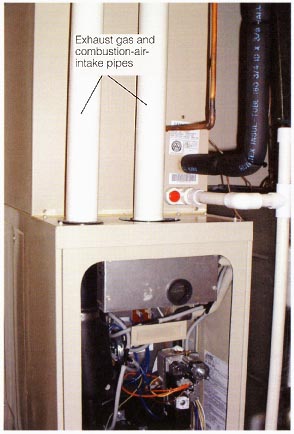Forced-air systems are relatively inexpensive to purchase and easy to maintain, making them one of the most popular types of whole- house heating. Because their design includes air ducts throughout the house, you have the option to add whole-house air-conditioning, humidification and air cleaning to the system. A forced-air system contains five main elements: a furnace, a net work of distribution ducts, registers on walls or floors, an exhaust flue and a thermostat. A motor-powered blower circulates air through the system. A few old furnaces still use gravity circulation, which relies on the natural convection created by the buoyancy of hot air and the fact that cold air falls. These systems have larger ducts and no blower.
Homes with ductwork can leak noticeably more air and require more
heating and cooling energy than homes without ductwork. The reason
is that forced air creates pres sure differences within the house that
can draw in outside air, force air out through cracks in the house
or pull outside air in through cracks in the house, all of which waste
heat.
To make sure your warm-air system works efficiently, clean or replace the filter regularly and follow the furnace tune-up steps on the following pages. Also, be sure your system has enough return ducts—at least one per level. In addition, seal all seams in duct work, and insulate ducts in unheated spaces. For improved comfort, adjust dampers and registers to balance heat distribution. Some furnaces and thermostats allow you to run the blower constantly at a low speed. It costs more for the electricity to run the blower, but your house will be more comfortable and evenly heated, and your burner may run less.

Above:
How a furnace works. The thermostat sends a signal to the burner located inside the combustion chamber which heats the outside of the heat exchanger. When the heat exchanger gets hot, the blower starts and pulls cool air into cold-air registers, through the cold-air return ducts, to the furnace. The return air goes through a filter to keep the blower clean. The air then passes through the inside of the heat exchanger, where it's warmed, safe from the burner combustion gases, which exit through the exhaust flue. Warm air is carried through the supply plenum and distribution ducts to warm-air supply registers in rooms.
Components of a furnace (as shown in image above): To supply plenum, Gas line, Distribution duct, Return or cold-air duct, Power switch, Burner, Filter, Blower, Combustion chamber, Heat exchanger.|
Monterey Top-Vent Wall Furnace, 50,000 Btu, Natural Gas with Wall or Cabinet-Mounted Thermostat Select from the lueader in combining high-efficiency home comfort with lower heating costs. Easy recessed or surface-mounted installation in homes, schools, cabins, apartments, offices and shops. Great during power outages, no electricity required. Patented, side-relief vent design reduces flue gas temperatures and also reduces operating costs. It is top vented and equipped with an automatic thermostat, safety controls, "matchless" pilot igniter and long-life ceramic-coated combustion chamber. |

High-efficiency Furnaces
Top-of-the-line furnace models can operate at very high levels of efficiency -- 95 percent or more. Their design features a second heat exchanger to draw usable heat from the exhaust gases. The cooler exhaust gas can then be routed through a small vent, often of PVC pipe, through an outside wall -- no conventional chimney is required. They also have a sealed combustion chamber and draw air from the outside, rather than inside. The downside is that the initial cost is greater and extra water-condensate from the exhaust must be piped or pumped to a drain.
